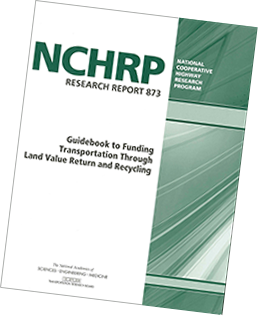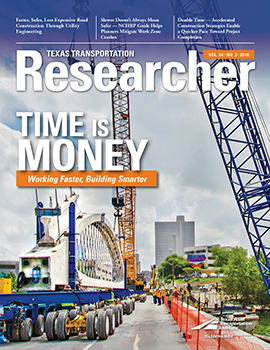According to the Texas Department of Transportation’s (TxDOT’s) Accelerated Construction Guidelines, a typical major highway project might take anywhere from 8 to 15 years. TxDOT says decreasing the time it takes to complete the preconstruction phase alone can save $100,000 to $500,000.
The construction phase of transportation improvements is often thought of as the determining factor in how long it takes to complete a project. But a key part of the process has to come first — securing funding. For example, obtaining voter approval for and issuing the bonds to fund a project can take years.

Improving access or capacity in a transportation corridor almost always results in economic development and increased land values. In 2007, Texas passed legislation authorizing the creation of transportation reinvestment zones (TRZs), an innovative value-capture finance method. TRZs allow a municipality (or other government unit) to fund an improvement project by borrowing against the incremental tax revenue projected to accrue from the value added to the area by the project itself. TRZs are simpler to set up than traditional tax increment financing methods, like tax increment reinvestment zones, since they only require a one-time approval by city councils and don’t need a governing board. Also, TRZs are difficult to rescind before they pay off the originally agreed upon share of project costs, making them fairly well insulated politically.
Property tax revenue collected by the municipality the year in which the TRZ is established will continue flowing to its general fund. However, future tax increments resulting from new development or increased property values beyond the base year amount are applied to paying off the improvement without increasing the property tax rate. When the TRZ expires and the improvement is paid off, the tax increment becomes again part of the city’s general property tax revenue.
“For example, improving a road connecting a coastal port to a state highway might be needed to accommodate growing truck volumes,” explains Texas A&M Transportation Institute (TTI) Senior Research Scientist Rafael Aldrete. “By estimating the expected development and value the improvement creates over, say, 30 years, the municipality can pledge the future incremental tax revenue to secure debt through the TxDOT state infrastructure bank or other related programs.”
For once, the egg can come before the chicken. By avoiding the time to issue bonds or employ other, more traditional funding mechanisms, TRZs can reduce the long-term construction project timeline (and associated costs) by fast-tracking the early step of securing funding. In its guidelines, TxDOT’s stated goal for reducing project costs is 20 to 50 percent. That can mean tens of millions of dollars in savings for the Texas taxpayer.
“In 2008, El Paso’s Comprehensive Municipal Plan aimed to fund an ambitious $1 billion in improvements that initially fell short of funding,” Aldrete says. “With TxDOT’s help and through TRZs, $70 million in funding was secured to close the gap, making various projects in the plan possible.”
Aldrete co-led the TTI team in 2009 that established standard procedures and guidance through a research project co-sponsored by TxDOT and the Federal Highway Administration. TTI developed tools to help agencies assess the viability of a TRZ and forecast how much an improvement might return over time in the form of tax increment revenue. TxDOT views TTI as an objective party, so the department regularly calls on Aldrete, now a nationally recognized value-capture expert, and his team. They help the department work with local governments to assess TRZ value capture opportunities along key transportation corridors.
Other states, like Virginia with its special assessment districts, have similar innovative finance mechanisms. In fact, national interest was so great in the practice that the National Cooperative Highway Research Program sponsored a project to document guidelines for states interested in using value capture options to fund their projects (see sidebar).
“Transportation reinvestment zones provide opportunities to fund significant transportation projects that would otherwise remain unfunded or be delayed indefinitely,” explains Walter Miller, mayor of Horizon City, Texas, a community near El Paso, when El Paso’s Comprehensive Municipal Plan was funded. Miller is currently a Horizon City alderman. “These opportunities grant local entities greater autonomy to proactively develop transportation projects that encourage deliberate and strategic land use and growth.”

